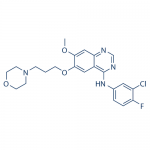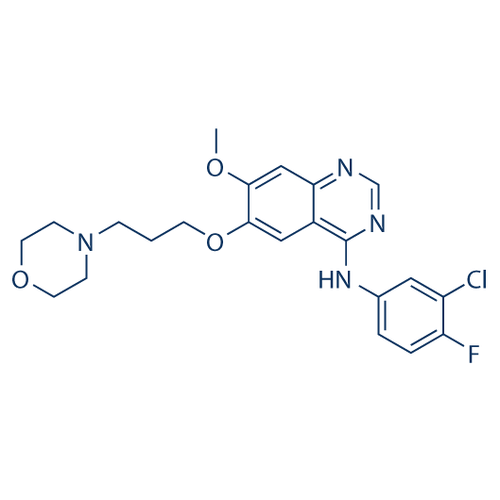| Product Name | Gefitinib |
| Description |
EGFR Kinase inhibitor |
| Purity | >99% |
| CAS No. | 184475-35-2 |
| Molecular Formula | C22H24ClFN4O3 |
| Molecular Weight | 446.9 |
| Field of Use | Not for use in humans. Not for use in diagnostics or therapeutics. For in vitro research use only. |
Properties
| Storage Temperature | -20ºC |
| Shipping Temperature | Shipped Ambient |
| Product Type | Inhibitor |
| Solubility | Soluble in DMSO (89 mg/ml at 25 °C), methanol (20 mg/ml), ethanol (4 mg/ml at 25 °C), DMF (20 mg/ml), and water (<1 mg/ml at 25 °C) |
| Source | Synthetic |
| Appearance | Solid |
| SMILES | C1=C3C(=CC(=C1OC)OCCCN2CCOCC2)C(=NC=N3)NC4=CC=C(C(=C4)Cl)F |
| InChI | InChI=1S/C22H24ClFN4O3/c1-29-20-13-19-16(12-21(20)31-8-2-5-28-6-9-30-10-7-28)22(26-14-25-19)27-15-3-4-18(24)17(23)11-15/h3-4,11-14H,2,5-10H2,1H3,(H,25,26,27) |
| InChIKey | XGALLCVXEZPNRQ-UHFFFAOYSA-N |
| Safety Phrases |
Classification: Not a hazardous substance or mixture. Safety Phrases: S22 - Do not breathe dust. S24/25 - Avoid contact with skin and eyes. S36/37/39 - Wear suitable protective clothing, gloves and eye/face protection. |
| Cite This Product | Gefitinib (StressMarq Biosciences Inc., Victoria BC CANADA, Catalog # SIH-445) |
Biological Description
| Alternative Names | N-(3-chloro-4-fluorophenyl)-7-methoxy-6-(3-morpholin-4-ylpropoxy)quinazolin-4-amine |
| Research Areas | Apoptosis, Cancer, Cancer Growth Inhibitors, Cell Signaling, Tyrosine Kinase Inhibitors |
| PubChem ID | 123631 |
| Scientific Background | Gefitinib is a selective inhibitor of EGFR tyrosine kinase that blocks receptor autophosphorylation. In neurodegenerative disease research, Gefitinib is used to investigate the role of EGFR signaling in glial activation, neuroinflammation, and neuronal survival. EGFR dysregulation has been associated with neurodegenerative conditions such as Alzheimer’s disease and glioblastoma. Gefitinib’s ability to modulate EGFR activity provides insights into therapeutic strategies targeting receptor-mediated signaling in the central nervous system. |
| References | 1. Ciardiello F., et al. (2000) Clin. Cancer Res. 6(5): 2053–2063. |



Reviews
There are no reviews yet.